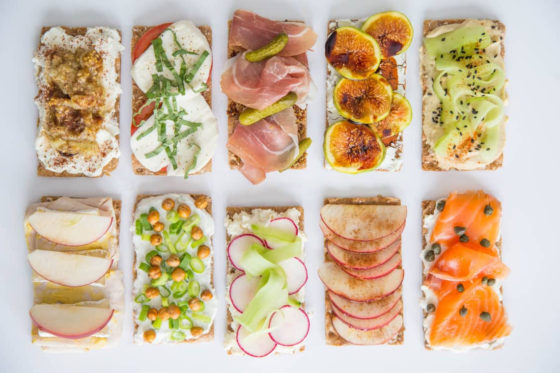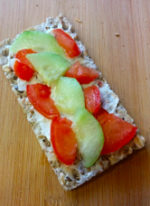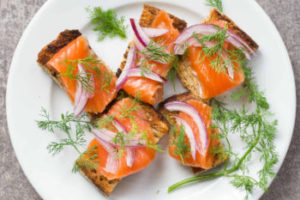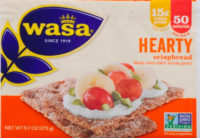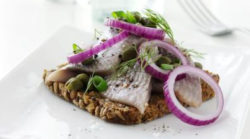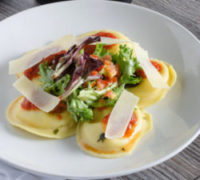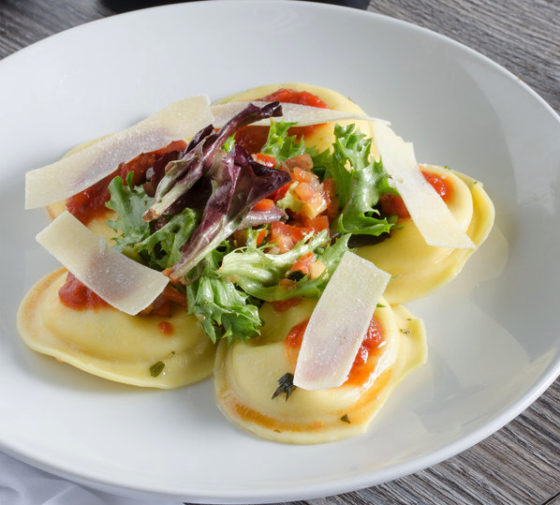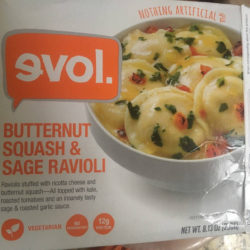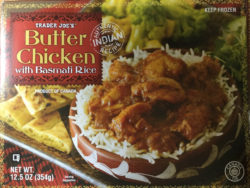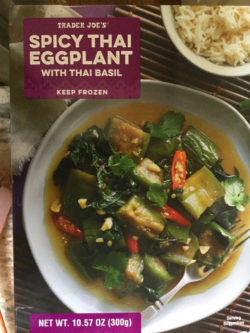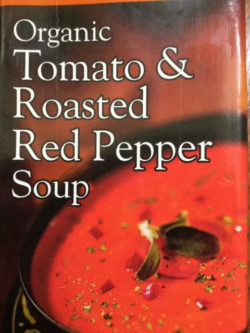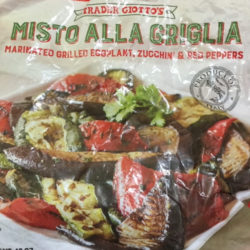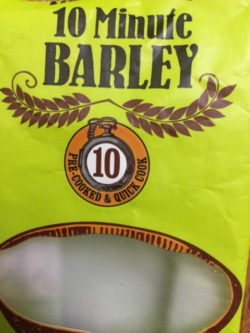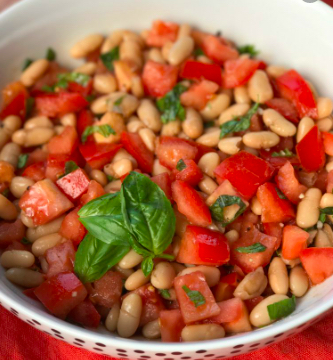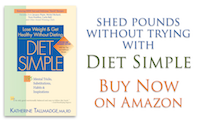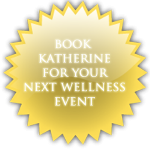The Vitamin Supplement You Should be Taking… Especially Now!
- At June 23, 2020
- By Katherine
- In Articles, News
 0
0
Vitamin D deficiency is linked to so many health conditions it’s mind boggling. And virtually none of us get enough, especially today.
When we first recognized Vitamin D’s significance about a century ago, all we knew is that a deficiency caused soft bones (rickets). Rickets causes children’s bones to become so flimsy, skeletal abnormalities flourish. For example, they literally can’t hold up their own bodies – causing extremely bowed legs. Adults acquire brittle bones (osteomalacia) which break easily.
Today, a growing body of research suggests that, beyond brittle bones, a Vitamin D deficiency influences a vast array of illnesses. It seems to increase your risk of hormone abnormalities, inflammation, oxidation and immune system suppression, all of which underly the development of numerous health conditions, including COVID-19.
Just to give you an idea about Vitamin D’s significance, it may promote the prevention and treatment of our most prevalent and destructive lifestyle disease, such as type 1 and type 2 diabetes, heart disease, hypertension, infectious diseases, glucose intolerance, even multiple sclerosis, and other medical conditions.
Vitamin D may decrease cancer risk, especially colon cancer, as well as breast, prostate, thyroid, liver, lung, prostate cancer, and even melanoma, a type of skin cancer. In fact, “Improvement in the quality of life of cancer patients receiving vitamin D supplementation has been documented in several studies,” according to a review of Vitamin D studies in the journal, Trends in Cancer Research.
Based on recent research, these conditions are more likely to be prevented and improved by having enough vitamin D in your system.
Why don’t we get enough Vitamin D? It is one of the rare essential vitamins we basically can’t get from food. It comes from sunshine, and our modern lives prevent us from getting an adequate supply – especially in isolation. Now, just imagine what the elderly are experiencing in isolation – for several months to date – as well as infants, children, or anyone who can’t venture outside. These are the most vulnerable population groups for not getting enough Vitamin D and that are susceptible to the consequences of Vitamin D deficiency. People of color are particularly at risk. Darker skin does not absorb sunshine as easily as lighter skin.
Back in the 1930’s, we practically eliminated rickets by adding 100 IU to eight ounces of milk. That gave us adequate Vitamin D. But that was then. This is now: Today’s limited sunshine exposure and milk intake, is allowing rickets to return with a vengeance, not only in children, but in adults, too.
Moreover, we’re now discovering the multitude of life-threatening illnesses its deficiency may be generating.
That’s because we spend most of our time indoors on our computers, working, watching TV, or in our cars. When we venture outside we’re covered in sunscreen, which blocks the ultraviolet (UV) rays necessary for producing Vitamin D in our bodies. While too much UV rays is strongly linked to skin cancer, careful skin exposure is recommended.
“It has been suggested by some vitamin D researchers that approximately 5–30 minutes of sun exposure between 10 AM and 3 PM at least twice a week to the face, arms, legs, or back without sunscreen usually leads to sufficient vitamin D synthesis,” according to the National Institutes of Health’s Office of Dietary Supplements.
The old, yet still prevailing recommendation for vitamin D is 400 IUs daily. Today, it’s unclear how much vitamin D each person needs to take because of variable sun exposure. But there seems to be a consensus among vitamin D scientists that blood values should be at least 50 ng/mL and there seems to be no benefit of going higher than 75 ng/mL, according to the National Academy of Sciences Food and Nutrition Board, the “gold standard” institution for state-of-the-art nutrition recommendations (though most medical labs consider 30 as adequate).
My clients and I take anywhere from 1,000 IUs (the lowest amount to take, I believe) to 4,000 IUs (the safe upper limit – UL) daily to achieve at least 50 ng/mL.
That said, be careful. Talk to your own physician about what you should do, considering your individual medical needs. That’s because, while natural sources in food and from the sun cannot cause overdoses, Vitamin D can be toxic when too much supplement is taken (4,000 IUs daily is the upper limit). In Europe in the 1950s, cases of soft tissue calcification, including in the heart and brain, led to mental retardation and other birth defects. It was caused by excessive vitamin D incorrectly added to the food supply. Ergo, supplementation has since been removed or scaled back in Europe.
Just like all nutrients, it’s important not to get too little – or too much. I call it the “Goldilocks effect,” because it needs to be just right!
Swedish New Potatoes with Fresh Dill
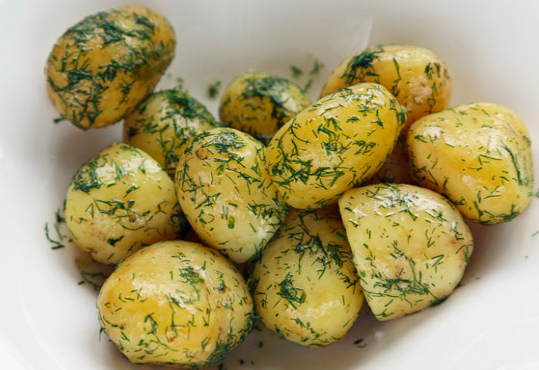 Potatoes are delicious boiled, the simplest and fastest preparation. In Sweden, they are customarily eaten on the same fork as gravlax (cured salmon) and mustard sauce. The combination is delectable. Potatoes are a traditional Swedish dish and served with just about every meal. Historically, Sweden’s fruit and vegetable choices were limited because it lies so far north. Potatoes were an important source of essential vitamins and minerals, preventing lethal deficiencies. Today that legacy continues.
Potatoes are delicious boiled, the simplest and fastest preparation. In Sweden, they are customarily eaten on the same fork as gravlax (cured salmon) and mustard sauce. The combination is delectable. Potatoes are a traditional Swedish dish and served with just about every meal. Historically, Sweden’s fruit and vegetable choices were limited because it lies so far north. Potatoes were an important source of essential vitamins and minerals, preventing lethal deficiencies. Today that legacy continues.
Ingredients:
2 lbs. small thin-skinned “new” potatoes**
1 dill stalk
½ tsp salt
¼ stick butter (2 Tbsp)
2 Tbsp rock salt or Kosher salt
freshly ground black pepper
Two to four Tbsp fresh clipped dill, to taste
Instructions:
1. Wash the potatoes. Just scrub them if you’d like to keep the skin on. Or scrape off the skins if you wish. Rinse the potatoes.
2. Place the larger potatoes over the base of a saucepan and pop the smaller ones on top. Pour in enough boiling water to not quite cover them, add some salt and the stalk of dill.
3. Cover with a tight-fitting lid and simmer gently for between 10 and 20 minutes. The cooking time depends on the variety and size. Test them with a skewer as they must be tender but still firm—overcooking really does spoil them.
4. Drain the potatoes and add the butter, the chopped fresh dill and a little pepper to the pan and then return the potatoes to the pan. Put the lid back on the pan and swirl the pan around to get each potato thoroughly coated.
5. Remove the lid, savor the delicious aroma and then sprinkle with a little rock or Kosher salt before serving them.
** “New” potatoes are freshly harvested young, or small, potatoes. They are the same varieties as their larger counterparts, but are harvested earlier in the season when they are sweet than their older counterparts. Also, because these potatoes are harvested young, their skins are very tender and flaky.
6 Savory Toppings for Crunchy Swedish Hard Bread
Variations for Open-Faced Swedish Hard Bread Sandwiches
Sweden’s Midsummer Festival is the celebration of the summer solstice, the longest day of the year, when the sun never sets.
At the Midsummer feast, it’s always traditional in Sweden to eat seafood, like herring, salmon and shrimp. Gravlax (cured salmon) is a favorite and prominent food in Sweden. Important vegetables and fruits from summer’s first harvest, like radishes, onions, potatoes and strawberries are featured, too. Dill is the herb used in abundance.
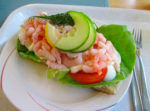
Swedish Shrimps are Tiny and Sweet, Very Different From Their American Cousins. Found in the freezer section of IKEA
With regard to Swedish hard bread toppings, think of what might be in American sandwiches and the options are endless. As well as the typical seafood and vegetables, cheese, cured venison and ham are regular additions. There are even modern versions with out-of-season vegetables using avocado, tomatoes, carrots and beets, you name it!.
Besides the flavor and crunch of Swedish hard bread, the nutrition and low calorie content are added bonuses! In the U.S., WASA bread is the most common brand of Swedish hard bread.
Pickled Herring, Fresh Dill and Sliced Red Onion on 100% Rye Coarse Hard Swedish Bread
Herring, fished locally, is omnipresent on the Swedish table. It is delicious pickled, smoked and grilled. It is a fragile fish – as are sardines and anchovies, its cousins – so it is mostly cured where it can’t be caught right out of the sea.
Since we in the U.S. are unlikely to find fresh herring (recipe below), it can be served with a store-bought version of pickled herring. It is easily found in the refrigerator section of virtually all grocery stores. The most authentic jarred pickled herring is found at IKEA.
Ingredients:
Pickled Herring, from a jar or home-made
Thinly Sliced Red Onion
Chopped Green Onions, optional for color
Thinly Sliced Potatoes, optional for smooth texture
Thinly Sliced Radishes, optional
Dollops of Swedish Mustard, optional
Directions:
Top the hard Swedish bread with thinly sliced boiled potatoes and smother with the pickled herring. Top with sliced red onion and dill.
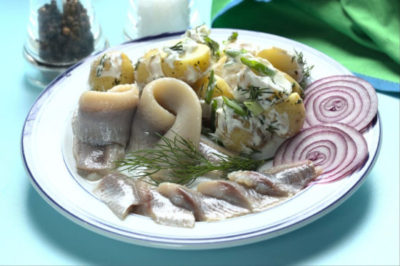
Home-made Pickled Herring
From SwedishFood.com
Herring spoils fast, so it is almost always cured. Pickled and smoked herring are especially prolific and popular in northern Europe.
7 oz salted herring fillets
(6 fl oz) water*
(4 fl oz) granulated sugar
2 fl oz vinegar, 12% if available
1/2 sliced red onion
6 white pepper corns
2 allspice berries, optional
1 pice of peeled horseradish
1 small piece of ginger (optional)
2 bay leaves (optional)
1. Soak rinsed filets in water while preparing the pickling liquid.
2. Place the water, vinegar and granulated sugar in a saucepan and bring to a boil, stirring until the sugar is dissolved. Leave to cool.
3. Drain the herring fillet, dab them dry with kitchen towel and cut them into ¾ inch wide pieces. Layer with all the remaining ingredients in a glass jar.
4. Pour the cold pickling solution over the herring and transfer to a fridge and keep for at least 24 hours before serving.
5. If the pickling solution becomes a little cloudy, pour it off and make a new solution, but allow it to cool before pouring it on to the herring.
My Favorite Asparagus Recipes
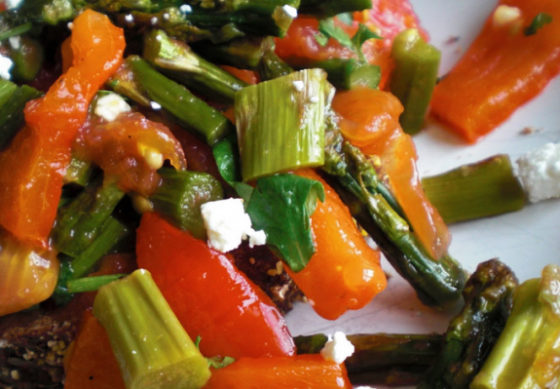
Asparagus, dating back to 3,000 BC, is considered a nutrition superstar because it is loaded with hundreds of vitamins, minerals and newly discovered nutrients called “phytochemicals” (“phyto” is Greek for plant) that impart impressive health benefits. Asparagus (family Liliaceae) possesses a variety of biological properties, such as antioxidant, immune-stimulant, anti-inflammatory, anti-hepatotoxic (helps the liver), and antibacterial.
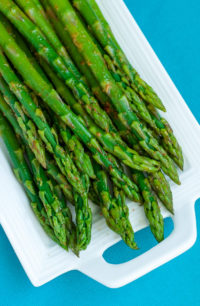 Asparagus is an excellent source of *essential vitamins like B1 (Thiamine), B2 (Riboflavin), and B9 (Folate), and Vitamin C, E and K. It contains some Vitamin A, B5 (Pantothenic Acid), B6 and Choline. It’s a good source of the essential minerals Iron, and contains some Calcium, Magnesium, Manganese, Phosphorus, Potassium and Zinc.
Asparagus is an excellent source of *essential vitamins like B1 (Thiamine), B2 (Riboflavin), and B9 (Folate), and Vitamin C, E and K. It contains some Vitamin A, B5 (Pantothenic Acid), B6 and Choline. It’s a good source of the essential minerals Iron, and contains some Calcium, Magnesium, Manganese, Phosphorus, Potassium and Zinc.
*Vitamins and minerals are considered “essential” when a deficiency would ultimately cause death.
Here are some of my favorite asparagus recipes from my book, “Diet Simple Farm to Table Recipes: 50 New Reasons to Cook In Season!,” along with many other seasonal recipes
Chilled Asparagus in a Creamy Tarragon, Shallot and Roasted Walnut Vinaigrette
Salad of New Potatoes and Asparagus with Lemony Garlic Herb Mayonnaise
Pasta with Pesto, Roasted Asparagus and Cherry Tomatoes
Asparagus Salad in a Vietnamese-Style Dressing
Keep Calm and Carry On… Simple Techniques for Calming Isolation Stress
- At June 16, 2020
- By Katherine
- In Articles, News
 0
0

Stress, anxiety and depression are at all-time highs, according to recent studies. Feeling stressed is a normal reaction to today’s crisis, but if prolonged, it can disturb your immune, digestive, cardiovascular, sleep, and reproductive systems. You may also experience digestive symptoms, headaches, sleeplessness, sadness, anger, or irritability, according to the National Institute of Mental Health.
I’m sure you have already realized that “This is not a crisis that adrenaline can get us through,” as Brené Brown said, research professor and social worker at the University of Houston, in a recent webinar. “We are in a long duration marathon, and we have to find a sustainable way [to live],” she added
I can help you create the sustainable way to live that improves your overall well-being – based on your own personalized needs – with just a few virtual sessions. Habit building leads to greater health. Now is the perfect time to craft exceptional life satisfaction! You can book at Katherine@PersonaledNutrition.com
In today’s article, I’d like to share some simple techniques to help reduce your stress, increase your energy and improve how you feel and cope.
Even if you exercise, I recommend you add some form of meditation to your daily routine. Before rolling your eyes, many activities you already do can qualify. The only requirement is that your activity choice contains the four elements I’ve described below:
1. Meditation is a mind and body practice with a long history for increasing calmness and physical relaxation, improving psychological balance, coping with illness, and enhancing overall health and well-being, according to the National Institute of Complementary and Integrative Medicine.
In my experience, meditation can also help you control destructive, stress-related habits such as emotional eating, cigarette, alcohol, drug abuse, and other impulsive or addictive behaviors.
There are many types of meditation, but most have four elements in common:
1) A quiet location with as few distractions as possible;
2) a specific, comfortable posture (sitting, lying down, walking, or in other positions);
3) a focus of attention (a specially chosen word or set of words, an object, or the sensations of the breath); and
4) an open attitude (letting distractions come and go naturally without judging them)
Try these two easy techniques – music and / or meditative movement – that have worked for me and my clients:
- Music. Have you heard that music soothes the savage beast (inside all of us)? Science proves it. Choose music that can get you in the “zone” and involves the four elements (listed above). Medieval music is one of my favorites for relaxing. Gregorian chants are popular. How about Celtic Music? Gentle nature sounds, like birds chirping, waves pounding on a beach, and rainstorms are popular. Religious music has been used for thousands of years to help worshipers concentrate. Try Tibetan music, too. Whatever floats yer boat!
- Meditative Movement is my favorite form of meditation and great for beginners. It uses movement in conjunction with meditative attention to body sensations, posture, rhythm and breathing: Tai Chi, a centuries-old martial art, Yoga, from 3,000 BCE and Qigong, more than 4,000 years old, are considered meditative movement practices. Tai chi is easy and very relaxing. I especially like this 8-minute beginners video.
2. Regular exercise releases natural feel-good brain chemicals like endorphins and seratonin, increasing feelings of well-being and happiness while reducing depression and anxiety. It can prevent the conditions that may make COVID-19 lethal, like obesity, diabetes and hypertension, but also heart disease, stroke, cancer and cognitive decline. Getting out into the fresh air is ideal. The coronavirus is less likely to spread outdoors, according to infectious disease specialists, and mask-wearing is only needed if you can’t socially distance at least 6 feet. But if inside with the public, mask wearing is essential. I also have some inexpensive ideas for indoor home exercise.
If you are experiencing more than stress, like severe anxiety or depression, please seek medical help. About 30% of the general U.S. population have symptoms of depression and/or anxiety, as reported by a recent Centers for Disease Control survey, with the highest rate – 40% – in 18 to 29 year-olds.
Will You Be a Hunk or a Chunk?
- At June 13, 2020
- By Katherine
- In Articles, News
 0
0

A client who works at the State Department told me about an inside joke between him and his colleagues… After their years-long assignments, who will come back as “hunks, chunks or drunks?!” I liken this to our experiences in isolation. So, what will you come out of isolation as?
Joking aside, I believe it’s time we answer this question. Because it has tremendous consequences for you and your family’s health, even your survival if you contract COVID-19, but also your energy, self-confidence and happiness, all of which you hold dear.
No doubt about it, it’s a tough time. Motivation can be hard to come by. Even if you love your home, your family, your neighbors, even if you consider yourself a homebody, as I do, isolation has been stifling for most of us.
In early March, I believed we would be in this for the long haul. Understanding human behavior as I hope I do, I had a feeling it might be challenging keeping to our healthy self-care routines. At that time, I talked to you about home exercise, how music reduces stress, creating a mediterranean diet pantry, delicious and easy microwave meals, scheduling your days, and my “guide for thriving,” 1,500 years-old wisdom that is still relevant today. It was created during the fall of the roman empire – also a very traumatic time!
If you haven’t read these articles, perhaps you might take a look? You could get some – or even just one – simple ideas that might make a difference for you now.
Set up an appointment to check in. Get some personalized ideas for you and your family for coming out of this ordeal a “hunk,” not a “chunk!”
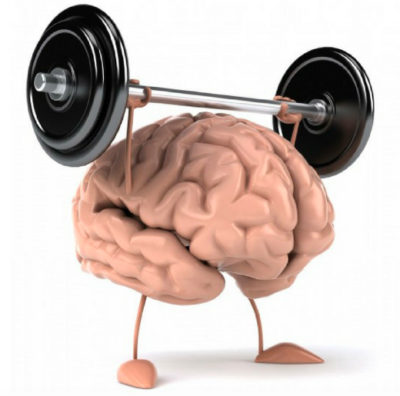
Expert Tips on Figuring Out if a Health Claim Will Work for You
- At June 04, 2020
- By Katherine
- In Articles, News
 1
1
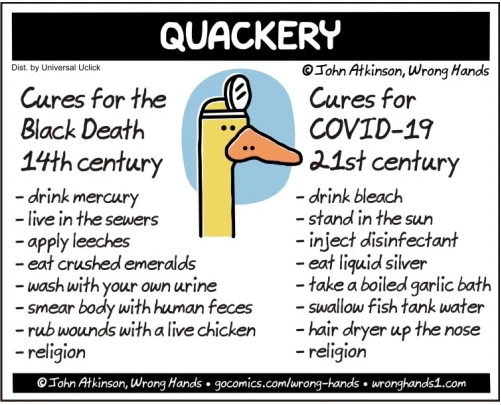
Living healthfully can be harder than you think, thanks to enterprising and sensationalized internet and media claims, blogs, articles, videos and websites.
How should you decide what health claims work? How would they work for you? How do you evaluate the science to ensure you are getting the most reliable and effective recommendations – ones that you and your doctor can trust, based on state-of-the-art scientific data?
 First, Consider the Source! Your Own Doctor(s)? A Qualified Medical Professional Who Specializes in the Field You Have a Question About?
First, Consider the Source! Your Own Doctor(s)? A Qualified Medical Professional Who Specializes in the Field You Have a Question About?
As a medically certified Registered Dietitian/Nutritionist, I personalize my recommendations for you based on a number of factors, as your doctor does. 1) I listen to what your goals are, 2) what you’d like to achieve, 3) I learn your medical conditions, 4) your medical history, 5) I gather your food or nutrition- related history, 6) biochemical data, 7) medical tests and procedures, 8) anthropometric measurements, 9) nutrition-focused physical findings, 10) your personal history and situation, 11) your family history, 12) your social history, 13) your habits, 14) your habits’ history, 15) your work life, 16) your family life, 17) what your doctor recommends, and more relevant information about your life. Then you and I, along with any of your doctor’s recommendations, decide on the best program for you, while continually monitoring, updating and supporting you along the way.
I was trained, as are all medical professionals, using the “scientific method.” The scientific method starts with a question. Then continues with systematic observation and experimentation, inductive and deductive reasoning, and the formation and testing of hypotheses and theories. It attempts to minimize the influence of bias or prejudice in the experimenter to discern how success is achieved.
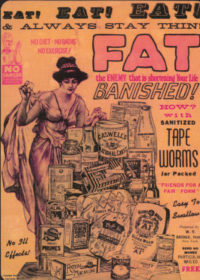 My obligation for the past 30+ years has been to stay informed of all scientific studies and findings relating to my field and to my clients’ specific needs. To achieve this, I never stop studying research in every medical field possible, but particularly nutrition, food, weight loss research and behavioral science. In fact, I’m required to have 75 continuing education credits every five years to maintain my “Registered Dietitian/Nutritionist” (RD/N) credentials. Continuing my studies is a life-long endeavor in my field because science is constantly evolving.
My obligation for the past 30+ years has been to stay informed of all scientific studies and findings relating to my field and to my clients’ specific needs. To achieve this, I never stop studying research in every medical field possible, but particularly nutrition, food, weight loss research and behavioral science. In fact, I’m required to have 75 continuing education credits every five years to maintain my “Registered Dietitian/Nutritionist” (RD/N) credentials. Continuing my studies is a life-long endeavor in my field because science is constantly evolving.
Second: From What Media Source Did The Health Claim Originate? My clients regularly send me claims they would like me to help them figure out. The first thing I need to find out is, what is the source of the claim? A newspaper article? A magazine or blog? A scientific journal? To continue my investigation, I’ll research the topic myself and ask:

- What have the past years or decades of research shown regarding this issue?
- What is the consensus from a variety of study types, populations, researchers and institutions?
- What are the quality of the studies, the researchers and the institutions?
- Are there any conflicts of interest related to the research?
Third: Was it a Legitimate Scientific Source? If I don’t already have the answer or want to research something myself, I’ll only go to scientific sources, ie, peer-reviewed, scientific journals.
Fourth: What Kind of Study Was Used and How Reliable Were the Study and the Researchers? There are five basic kinds of studies…
1. Randomized Controlled Trials: If you want to know how effective a treatment or diet is, randomized trials provide the most reliable answers. “Randomized” means divided into groups by chance. In RCTs participants are randomly assigned to one of two or more groups. Then one group receives the new diet or food being experimented with, while the other group receives something different, conventional, or a placebo. If the RCT is “double-blind,” (the gold standard), neither the researchers nor the subjects know who is receiving the treatment or the placebo so that the findings are as unbiased as possible. Examples: The 1. DASH (Dietary Approaches to Stop Hypertension) Diet Study, the first study establishing that fruits, vegetables and low fat dairy products lower blood pressure, a study of how 2. Gut Health Influences Insulin Resistance, a precursor to diabetes, and how 3. Drinking Tea and Tai Chi Exercise Prevent Bone and Muscle Loss in Post-Menopausal Women.
 2. Cohort Studies observe a group of people frequently over a period of many years – for instance, to determine how often a certain disease occurs. In a cohort study, two (or more) groups that are exposed to different things are compared with each other: For example, one group might drink alcohol while the other doesn’t. Or one group may eat a high fiber diet and the other doesn’t. The researchers then observe how the health of the people in both groups develops over the course of several years, whether they become ill, and how many of them pass away. Some prominent examples are 1.Harvard’s Women’s Health Study, 2. The Framingham Heart Study, 3. The National Weight Control Registry Study.
2. Cohort Studies observe a group of people frequently over a period of many years – for instance, to determine how often a certain disease occurs. In a cohort study, two (or more) groups that are exposed to different things are compared with each other: For example, one group might drink alcohol while the other doesn’t. Or one group may eat a high fiber diet and the other doesn’t. The researchers then observe how the health of the people in both groups develops over the course of several years, whether they become ill, and how many of them pass away. Some prominent examples are 1.Harvard’s Women’s Health Study, 2. The Framingham Heart Study, 3. The National Weight Control Registry Study.
3. Case-Control Studies compare people who have a certain medical condition with people who do not, but who are as similar as possible, for example, the same sex and age. Then the two groups are interviewed, or their medical files are analyzed, to find anything that might be risk factors for the disease. They are not as expensive or time-consuming as RCTs or cohort studies. But their limitations are that it is often difficult to tell which people are the most similar to each other and because the researchers usually ask about past events, they are dependent on the participants’ memories. For instance, this study looking at Dietary Patterns, Nutrition, and Risk of Breast Cancer.
4. Cross-Sectional Studies: The classic type of cross-sectional study is the survey: A representative group of people – usually a random sample – are interviewed or examined in order to find out their opinions or facts. Because this data is collected only once, cross-sectional studies are relatively quick and inexpensive. They can provide information on things like the prevalence of a particular disease. But they can’t tell us anything about the cause of a disease or what the best treatment might be. For instance, this Analysis of Unhealthy Foods, Race/Ethnicity, Sex, and Cardiometabolic Risk Factors in U.S. Adults.
5. Qualitative Studies help us understand, for instance, what it is like for people to live with a certain disease. Unlike other kinds of research, qualitative research does not rely on numbers and data. Instead, it is based on information collected by talking to people who have a particular medical condition and people close to them. Written documents and observations are used too. The information that is obtained is then analyzed and interpreted using a number of methods. For instance, this study exploring Influences on Food Choices of University Students.
The final but most important question: What is the best way to translate this science to recommendations that my clients and doctors trust and that they can use in their everyday lives? Well, you could say that’s where art mixes with science!
Katherine’s Silver Lining Approach: Your Mediterranean Diet Pantry & Featured Recipe

What science has discovered as the ideal diet hasn’t changed for more than half a century. What we’ve learned since then, though, are why and how the diet is so perfect. It’s worth making the switch, for many reasons! For one, it boosts your body’s immune system dramatically, thus, its ability to fight diseases from colds to flu, cancer, heart disease, diabetes, arthritis, Alzheimer’s, even today’s scourge: COVID.
The Mediterranean Diet is a complex diet containing many foods that contribute to its health benefits. It’s plant-based, high in vegetables, fruits, legumes, whole grains, nuts, seeds, fish, low-to-moderate in high fat dairy and red meat (very low in saturated – animal – fat) and the occasional glass of wine. Olive oil is the diet’s principal source of fat.
It was first observed in the 1950s by nutrition scientist, Ancel Keys, that people in Greece, southern Italy, southern France and other countries bordering on the Mediterranean, eating their local food, experienced few nutritional problems and rarely suffered from heart disease. Since then, many studies have confirmed that this mixture of foods we now call the Mediterranean diet has significant properties which may help prevent not only heart disease, cancer, diabetes, Alzheimer’s, dementia, arthritis, many of the diseases of aging, and even weight gain.
While every element in the Mediterranean diet is important, eating fresh, 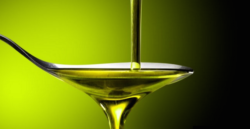 extra-virgin olive oil may trump everything. The type of fat you eat is critical to your health. This is because fat ends up in all of your body’s cells. It acts as a cell lubricant, improves flexibility and communication between cells, and is important for cell metabolism and gene expression. If the fat you eat is saturated – solid at room temperature – as in butter or animal fat – this decreases cellular flexibility and functioning. So, following the Mediterranean diet, but eating the wrong kind of fat, could reduce your health benefits.
extra-virgin olive oil may trump everything. The type of fat you eat is critical to your health. This is because fat ends up in all of your body’s cells. It acts as a cell lubricant, improves flexibility and communication between cells, and is important for cell metabolism and gene expression. If the fat you eat is saturated – solid at room temperature – as in butter or animal fat – this decreases cellular flexibility and functioning. So, following the Mediterranean diet, but eating the wrong kind of fat, could reduce your health benefits.
Olive oil, the staple of the Mediterranean diet, is unique in many ways. First, it’s made from a fruit which is exposed to the elements. This exposure forces olives to synthesize antioxidants and anti-inflammatory nutrients to protect themselves and concentrates the valuable nutrients in the oil, which is high in compounds called polyphenols, Vitamin E and carotenoids, like beta-carotene. New research shows high polyphenol olive oil turns OFF genes that cause the metabolic syndrome, the constellation of high blood pressure, blood sugar and cholesterol.
Polyphenols are also found in wine, tea and cocoa and are known for protecting the heart in many ways – reducing blood clotting, lowering bad (LDL) cholesterol, raising good (HDL) cholesterol and lowering blood pressure. Vitamin E is a well-known antioxidant which helps prevent oxidation and cellular aging and may help prevent diseases such as cancer. Caretenoids are plant compounds giving the olive its color. They’re important for your immune system, your skin, your vision, bones, reproduction, and may reduce cancer risk. Olive oil is also high in heart-healthy monounsaturated fatty acid called Oleic acid.
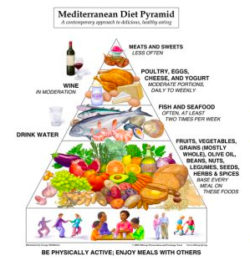 Eating the Mediterranean diet is the most economical way to eat. In fact, it is a diet borne of poverty. The original Mediterraneans, who ate the purest form of the diet in the 1950s and 60s, ate mostly fruits, vegetables, whole grains, nuts, seeds, legumes, fish, and olives, all of which were local. This is all they could afford and it happened to be the healthiest diet on the planet. They were also quite thin and naturally very active in their regular routines. All of these factors contribute to its health benefits
Eating the Mediterranean diet is the most economical way to eat. In fact, it is a diet borne of poverty. The original Mediterraneans, who ate the purest form of the diet in the 1950s and 60s, ate mostly fruits, vegetables, whole grains, nuts, seeds, legumes, fish, and olives, all of which were local. This is all they could afford and it happened to be the healthiest diet on the planet. They were also quite thin and naturally very active in their regular routines. All of these factors contribute to its health benefits
Olive oil’s beneficial health properties, its polyphenol content and acidic pH, degrade over time, as days, weeks, and months go by after harvest. Other factors play a role, too: the harvesting method, the age of the trees, the ripeness of the olives, the processing, and the storage. Since time, heat, and light affect polyphenol content, choose olive oil that:
- Is no more than one year old (look for the harvest date – not a sell-by date – on the label),
- Is in an air-tight, dark glass, or tin container,
- Is stored in a cool environment, and
- Smells and tastes like olives, which could be fruity, grassy, or peppery.
The Mediterranean Diet pantry
This is the perfect way of eating during our collective isolation. It’s inexpensive and most foods can be dry, frozen or canned, when fresh aren’t available, which is the case this time of year. Some examples:
- Canned chopped tomatoes, or any frozen fruits and vegetables
- Dry or canned beans, peas, whole grains such as bulgur, barley, oats, canellini beans, black beans, lentils, chick peas,
- Nuts and seeds
- Fresh lemons, and citrus fruit or vinegar, and olive oil for salad dressings, canola oil for cooking with high heat,
- Fresh onions, garlic, and root vegetables when available,
- Canned wild Alaskan Salmon, herring, anchovies, sardines,
- Whole wheat breads, pasta, crackers and cereals
- Dry or fresh herbs and spices such as basil, rosemary, marjoram, thyme, oregano,
- Yogurt, enough to eat daily for its natural probiotic benefits,
- Cheeses such as Mozzarella, Ricotta, with small amounts of Parmesan and Reggiano.
- Eggs
Katherine’s White Beans with Garlic and Basil
Excerpted from Diet Simple by Katherine Tallmadge, MA, RDN, LD
This is the perfect Mediterranean recipe. My friends love these beans. I love these beans. They’re always a hit. Every time I serve them, I’m asked (begged) for the recipe. They taste deceptively rich and are easy to make. The abundance of fresh basil added at the end fills the house with irresistible aromas. This is a warm and satisfying dish which can be eaten in many ways. My friend David uses them as a dip (what can I say, he`s a shrink and a priest!). My (very healthy) friend Alan loves them so much he eats them for breakfast! I bring them to potlucks.
I love to fill a large plastic container with them in the frig, ladle a heap into a microwave-safe bowl, and heat them up for lunch along with a slice of hearty whole grain bread topped with smoked turkey, salmon, light cheese (or all of the above) – and some crunchy lettuce. One of our favorite ways to eat these beans is with spicy chicken sausage. Just slice a spicy chicken sausage of your choice into a microwave-safe bowl, smother with the beans and pop in the microwave. Together with a greens salad and a tart dressing, you’ve got a winning combination.
I usually double the recipe so I have plenty of servings during the week. Without any meat, it’ll last more than a week in the frig.
4 servings
Ingredients:
1/2 pound dried small white (cannellini) beans, or 24 oz. canned rinsed bean
1 Tbsp Olive Oil
1-1/2 Onion, Chopped
4 Garlic Cloves (more or less to taste)
1 Quart defatted Chicken or Vegetable Stock (only 2 Cups if using canned beans)
Salt and pepper to taste
12 Oz. (3 medium) fresh or canned Tomatoes, drained, peeled and chopped
1 Large Handful of Fresh Basil
Juice from 2 to 4 Lemon (1/4 to ½ cup)
Freshly Ground Pepper, to taste
Directions:
If you’re using dried white beans:
Soak the beans in one quart of water overnight or up to 24 hours. Drain and rinse. Add one quart Chicken Stock (or more if you like the dish more soupy) to the beans along with one clove of garlic and 1/2 onion. Bring to a boil, reduce heat, cover, and simmer 1-1/2 hours or until the beans are almost tender. Add more water or stock to keep moist. Add salt to taste and finish cooking until beans are tender.
Continue with your cooked dried beans or start here if you’re using canned white beans:
Heat the oil in a large, heavy soup pot or casserole and sauté the remaining one onion and garlic over low to medium heat for 10 or 15 minutes or until soft and caramelized. Add the tomatoes, and more salt to taste and bring to a simmer. Simmer about ten minutes then add the beans with their cooking liquid and simmer 15 – 20 minutes. If you used canned beans, use enough stock to keep the beans moist while cooking. At the end of the cooking time, add the fresh basil (it will get bitter if overcooked), fresh lemon juice, and freshly ground pepper. Mix together.
You can also add greens to this dish for more authentic Mediterranean flavors and nutrition.


